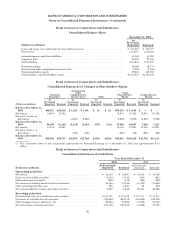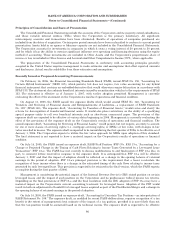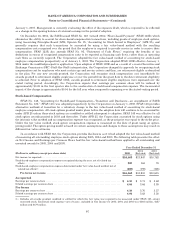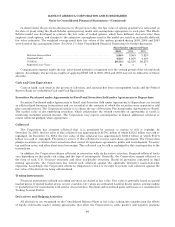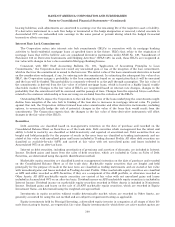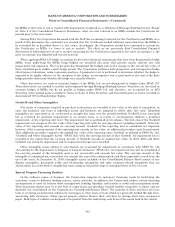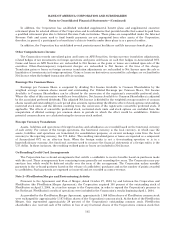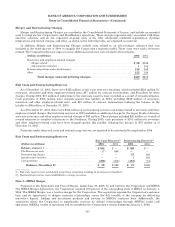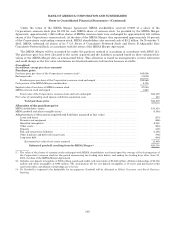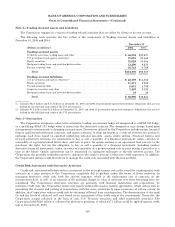Bank of America 2005 Annual Report Download - page 135
Download and view the complete annual report
Please find page 135 of the 2005 Bank of America annual report below. You can navigate through the pages in the report by either clicking on the pages listed below, or by using the keyword search tool below to find specific information within the annual report.BANK OF AMERICA CORPORATION AND SUBSIDIARIES
Notes to Consolidated Financial Statements—(Continued)
and offset cash collateral held with the same counterparty on a net basis. For exchange-traded contracts, fair value is
based on quoted market prices. For non-exchange traded contracts, fair value is based on dealer quotes, pricing models
or quoted prices for instruments with similar characteristics.
The Corporation recognizes gains and losses at inception of a contract only if the fair value of the contract is evidenced
by a quoted market price in an active market, an observable price or other market transaction, or other observable data
supporting a valuation model in accordance with EITF Issue No. 02-3, “Issues Involved in Accounting for Derivative
Contracts Held for Trading Purposes and Contracts Involved in Energy Trading and Risk Management Activities”.For those
gains and losses not evidenced by the above mentioned market data, the transaction price is used as the fair value of the
contract. Any difference between the transaction price and the model fair value is considered an unrecognized gain or loss at
inception of the contract. These unrecognized gains and losses are recorded in income using the straight line method of
amortization over the contractual life of the derivative contract. Earlier recognition of the full unrecognized gain or loss is
permitted if the trade is terminated early, subsequent market activity is observed which supports the model fair value of the
contract, or significant inputs used in the valuation model become observable in the market.
The Corporation designates at inception whether the derivative contract is considered hedging or non-hedging for
SFAS 133 accounting purposes. Non-hedging derivatives held for trading purposes are included in Derivative Assets or
Derivative Liabilities with changes in fair value reflected in Trading Account Profits. Other non-hedging derivatives that
are considered economic hedges, but not designated in a hedging relationship for accounting purposes, are also included
in Derivative Assets or Derivative Liabilities with changes in fair value recorded in Trading Account Profits, Mortgage
Banking Income or Other Income on the Consolidated Statement of Income. Credit derivatives used by the Corporation
do not qualify for hedge accounting under SFAS 133 despite being effective economic hedges with changes in the fair
value of these derivatives included in Trading Account Profits. Changes in the fair value of derivatives that serve as
economic hedges of MSRs are recorded in Mortgage Banking Income, after June 1, 2004. Changes in the fair value of
derivatives that serve as ALM economic hedges, which do not qualify or were not designated as accounting hedges, are
recorded in Other Income.
For SFAS 133 hedges, the Corporation formally documents at inception all relationships between hedging
instruments and hedged items, as well as its risk management objectives and strategies for undertaking various
accounting hedges. Additionally, the Corporation uses dollar offset or regression analysis at the hedge’s inception and for
each reporting period thereafter to assess whether the derivative used in its hedging transaction is expected to be and
has been highly effective in offsetting changes in the fair value or cash flows of the hedged items. The Corporation
discontinues hedge accounting when it is determined that a derivative is not expected to be or has ceased to be highly
effective as a hedge, and then reflects changes in fair value in earnings after termination of the hedge relationship.
The Corporation uses its derivatives designated as hedging for accounting purposes as either fair value hedges, cash
flow hedges or hedges of net investments in foreign operations. The Corporation manages interest rate and foreign
currency exchange rate sensitivity predominantly through the use of derivatives. Fair value hedges are used to limit the
Corporation’s exposure to total changes in the fair value of its fixed interest-earning assets or interest-bearing liabilities
that are due to interest rate or foreign exchange volatility. Cash flow hedges are used to minimize the variability in cash
flows of interest-earning assets or interest-bearing liabilities or forecasted transactions caused by interest rate or foreign
exchange fluctuation. The maximum length of time over which forecasted transactions are hedged is 29 years, with a
substantial portion of the hedged transactions being less than 10 years. Changes in the fair value of derivatives
designated for hedging activities that are highly effective as hedges are recorded in earnings or Accumulated OCI,
depending on whether the hedging relationship satisfies the criteria for a fair value or cash flow hedge. Hedge
ineffectiveness and gains and losses on the excluded component of a derivative in assessing hedge effectiveness are
recorded in earnings in the same income statement caption that is used to record hedge effectiveness. SFAS 133 retains
certain concepts under SFAS No. 52, “Foreign Currency Translation,” (SFAS 52) for foreign currency exchange hedging.
Consistent with SFAS 52, the Corporation records changes in the fair value of derivatives used as hedges of the net
investment in foreign operations as a component of Accumulated OCI, to the extent effective.
The Corporation, from time to time, purchases or issues financial instruments containing embedded derivatives. The
embedded derivative is separated from the host contract and carried at fair value if the economic characteristics of the
derivative are not clearly and closely related to the economic characteristics of the host contract. To the extent that the
Corporation cannot reliably identify and measure the embedded derivative, the entire contract is carried at fair value on
the Consolidated Balance Sheet with changes in fair value reflected in earnings.
If a derivative instrument in a fair value hedge is terminated or the hedge designation removed, the previous
adjustments of the carrying amount of the hedged asset or liability are subsequently accounted for in the same manner
as other components of the carrying amount of that asset or liability. For interest-earning assets and interest-
99








